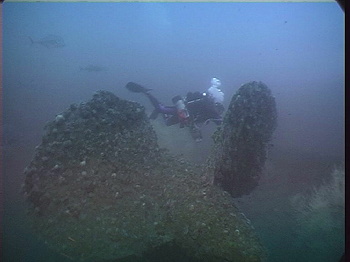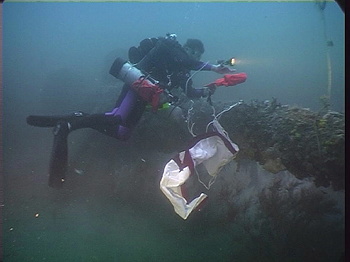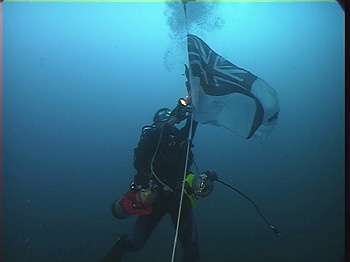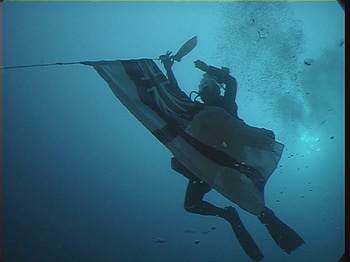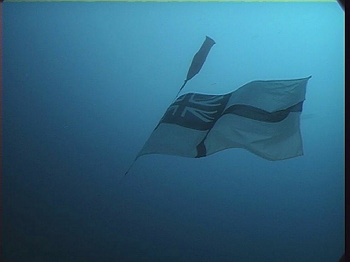16 SEPTEMBER
2001
By ten in the morning we had arrived at Tioman Island with more passport checks at Malaysian Customs prior to entering Malaysian waters! The sea was flat calm and as we prepared kit and headed off for Admiral Sir Tom Phillips' Flagship "The Prince of Wales" and there was a growing sense of anticipation. ITN busied themselves and Dave Taylor (the Diving Officer for the trip) briefed the divers.
The first dive was planned for 25 minutes of bottom time using 17/40 Trimix, 36% Nitrox as a travel gas and 50% Nitrox as a deco gas. Rod Macdonald (author of Dive Scapa Flow and Dive Scotland's Greatest Wrecks) carried out a wreck orientation and went over where the torpedo damage from the Japanese Betties (torpedo planes) should be. The first two pairs of divers (all on Aqua Zepps) kitted up and headed for the shot. The Zepps made slow progress into the strong current but the first pair (Dave Taylor and Rod Macdonald) soon disappeared under the water. Guy Wallis (The Expedition Leader) and Dan Burton soon followed.
Dave and Rod hit amidships on the starboard side and tried to ensure the thick mooring line from the Mata Ikan was properly tied into the wreck. The line was snagged on a large pipe running from the bulwark rail upwards - this was later identified as a torpedo boom. After almost ten minutes of grafting with the heavy rope the pair failed to find a suitable tie off point and headed aft at a depth of 65m meters. The ship is almost completely upturned with a gap between the side off the ship and the bottom of approximately 4-5 metres on the starboard side.
As they passed aft they moved past the 5.25 inch anti aircraft gun turret with its twin barrels extended out over the starboard side of the ship. The ship whilst sinking had heeled over to port and the barrels were possibly trained out to starboard in a vain attempt to slow the list to port caused by the first two torpedo strikes on the port side during the first wave of the attack. The second and final wave of the attack however was on the starboard side and the guns may simply still be in their last firing position prior to the sinking.
They then passed a large blast hole beneath the waterline caused by a torpedo hit - the plates bent inwards at the edge. After reaching the props their allotted time on the bottom of 25 minutes was spent and it was time to start the long and slow ascent to the surface far above.
Meanwhile Guy and Dan had run into trouble. Guy's Zepp had packed up at 30 meters and had to be clipped off on the shot line. Not to be deterred and determined to place the ensign on one of the prop shafts they pressed on. Guy, swam along the top of the upturned hull while Dan scootered along filming the whole affair. Apart from the depth it was easy to imagine you were on a coral reef. Shoals of Barracuda and Jacks circled around as the two passed large patches of soft coral.
After approximately 200 meters the props loomed into view. Guy moved down to the lower one on the starboard side and carefully removed the White Ensign from its storage position. The Ensign's lanyard was wrapped and shackled around the prop shaft and Guy then inflated the attached deco bag. The Ensign rose majestically for 15 feet slowly unfurling. As the current caught the Ensign, once again, 60 years after its sinking a British flag flew on this once proud lady of the seas - a fitting tribute to those who perished. They shall not be forgotten.
